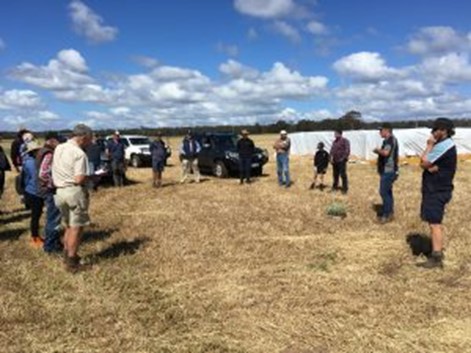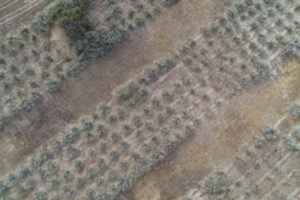
How deep would you plant a saltbush seedling? The answer surprised farmers who attended the Forage Options field day at Bell Pasture Seeds recently.
Saltbush is often used on marginal lands to address problems such as vitamin and mineral deficiencies, reducing supplementary feeding, covering marginal land at risk of erosion, provision of shade and shelter for stock and reducing groundwater recharge. However, for farmers used to growing and grazing crops and pastures, establishing and managing shrubs can be a whole new world.
To provide farmers with some basic management considerations, South West NRM invited Dustin McCreery from Chatfield’s Tree Nursery in Tammin to speak at the field day.
Chatfield’s Tree Nursery is the national licensee for AnamekaTM saltbush, a highly palatable variety of oldman saltbush selected from 60,000 individual plants as part of CSIRO-led research.
Dustin said that it’s important for farmers to discuss the particular problem they want to address with a nursery before designing a forage shrub planting. However, he was able to speak about some of the more common approaches to growing and using saltbush.
“One of the more common ways of setting up a saltbush paddock is to set up a paddock for shade and shelter,” Dustin said.
“These are usually 10 to 20-hectare areas with rows of shrubs in blocks of four to six rows, planted about 2.5 to 3 metres apart. There’s a gap between each block of rows wide enough for a ute or machine, and blocks can also be split perpendicularly to the row direction to make mustering easier.”
Design is influenced by the rainfall, with high rainfall areas capable of supporting a maximum of 1,200 stems per hectare, medium rainfall about 1,000 and low rainfall 800. This means that in the high rainfall zone, shrubs can be planted closer along the row, such as 1.5 to 2 metres apart.
The gap or inter-row between the blocks could be sown to pastures prior to planting seedlings in winter.
“You could spray out and seed the interrow, then come back in with trees in August with a pre-strip spray. Glyphosate is the only thing I recommend before trees,” Dustin said.
For farmers looking to grow perennial pastures, the inter-row may be a good location according to the event’s host Rob Bell from Bell Pasture Seeds.
“If you go down the line of planting perennial grasses and clovers, do them under these shrubs, not out in the open where the heat knocks them around. It creates a better environment for them to survive. Plants under extreme stress become unpalatable.”

Dustin said that ripping a fracture in the ground is very important, consisting of a single rip line to concentrate water where seedlings will be planted. This could be done when pastures are seeded or even earlier.
“Timing is important too, don’t do it when the ground is too wet,” Dustin said.
Just like perennial pastures, weed management is a key aspect of establishing shrubs.
“If you transplant where something has already germinated, it’s got a head start,” Dustin said. “So preparation is key. You can spray or mechanically scalp. I like scalping because you’re taking the weed seed burden away.”
This brings us to the question posed at the start of the article – How deep do we plant?
“A lot of people plant too shallow. Seedlings are grown so they can be planted deep, leaving the top few leaves that will do the growing. You don’t want too many leaves transpiring and putting pressure on a small root system looking for moisture.”
Final recommendations were to pack plants tightly into the soil, keep chemicals away from the seedlings and don’t leave the gate open and let the stock in!
Eventually, stock can be let in the following autumn for a light graze when plants are about knee-high. The first graze should leave about 60% of leaves on the plants so they can recover. Then, farmers can choose to either graze two-to-four times per year, leaving 30-40% of leaves behind for recovery after each graze, or apply a single heavy graze once a year.
“Some clients will go down to zero leaves, but then won’t graze for another 12 months so the plants can recover. However, the majority of clients are now rotationally grazing. We’ve got clients doing three or four grazings’ a year, but they leave 30-40% of leaves on the plant.”
A key consideration for grazing shrubs is that both sheep and cattle will only use shrubs for 30% of their diet.
“You’re going to have to supplementary feed with stubble or hay, lupins for protein and freshwater. Just make sure these are spread around the paddock, so stock don’t concentrate in one area.”
In terms of other species, Dustin said that river saltbush can be utilised as part of a package if areas of waterlogged soils exist in the paddock, but tagasaste can be difficult to manage because it needs to be slashed, and if it doesn’t get managed properly it can escape and become a weed.
For more information and assistance in addressing your problems with shrubs, speak to your local nursery. However, be aware that nursery space is limited, and orders need to be made by November in most cases and earlier for some.
For more reading on saltbush, see Saltbush a valuable supplement for marginal land
